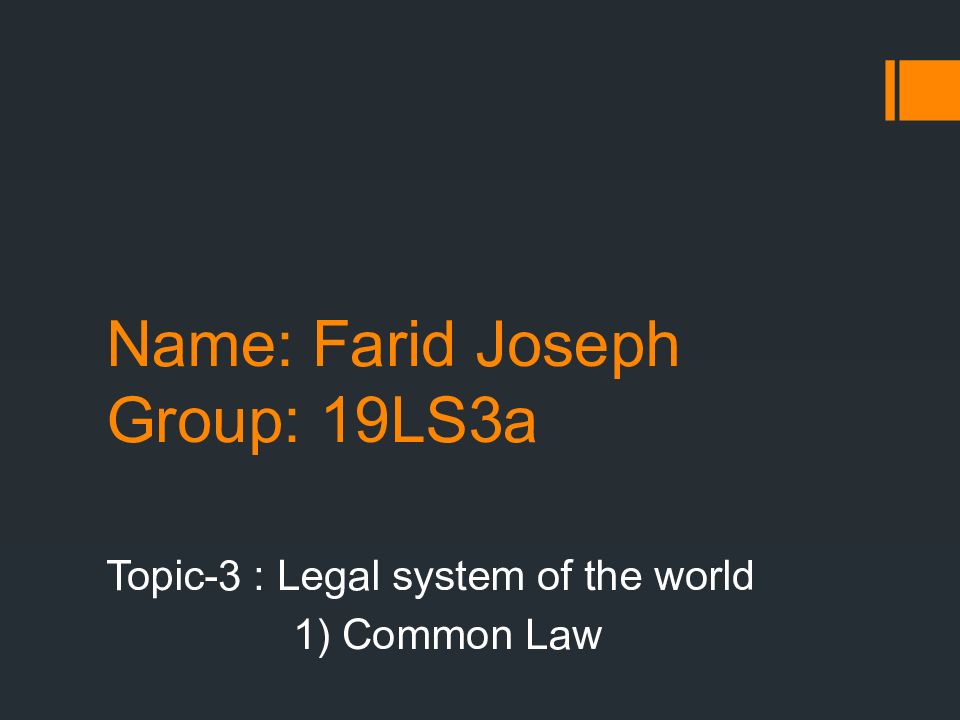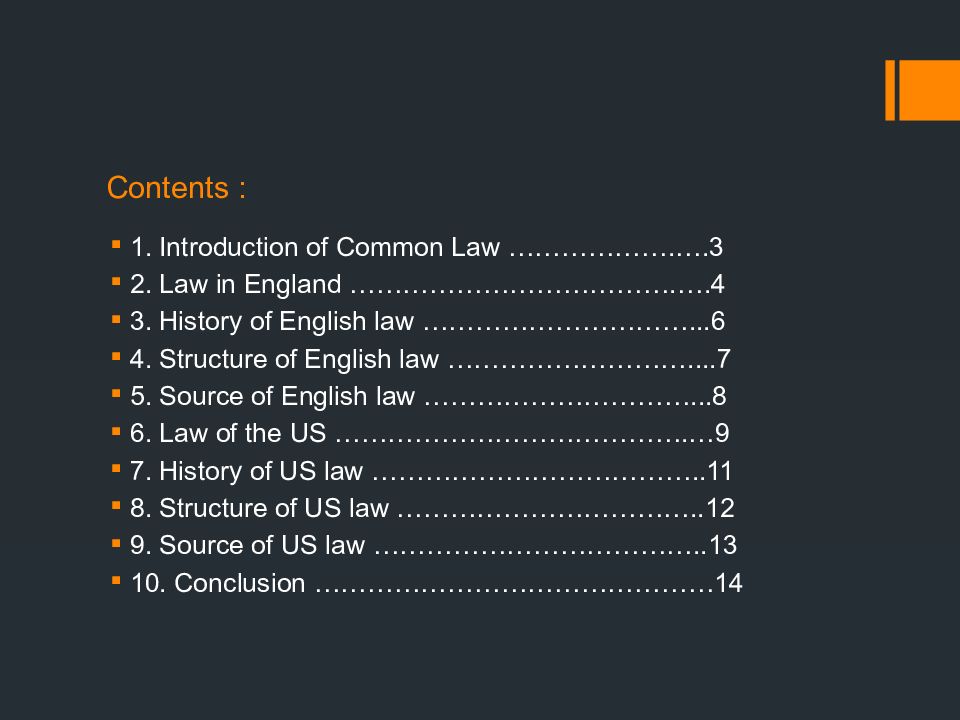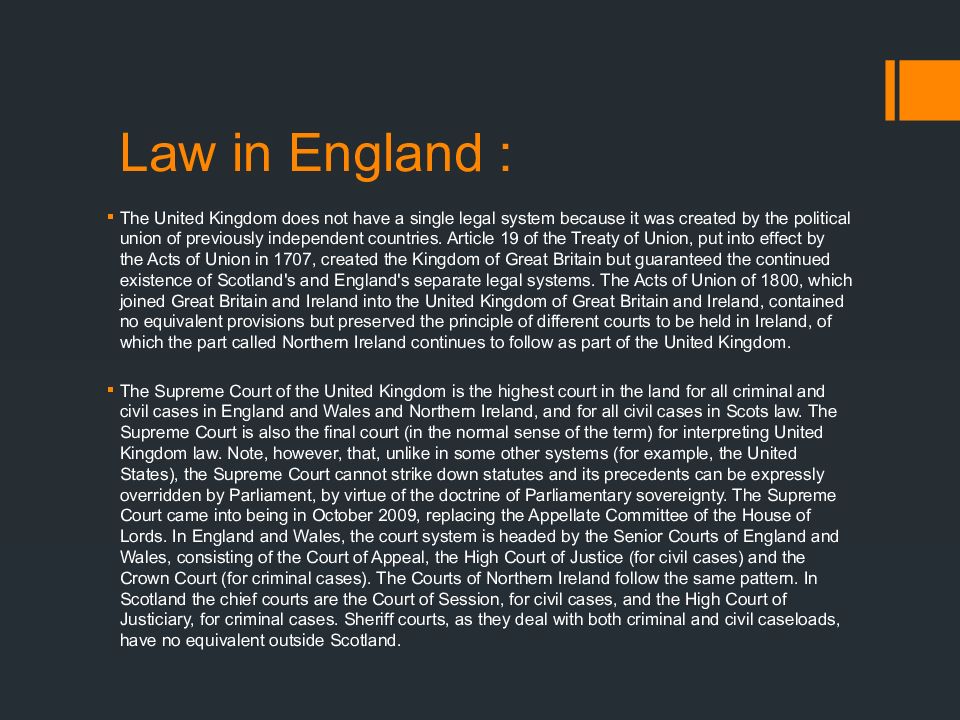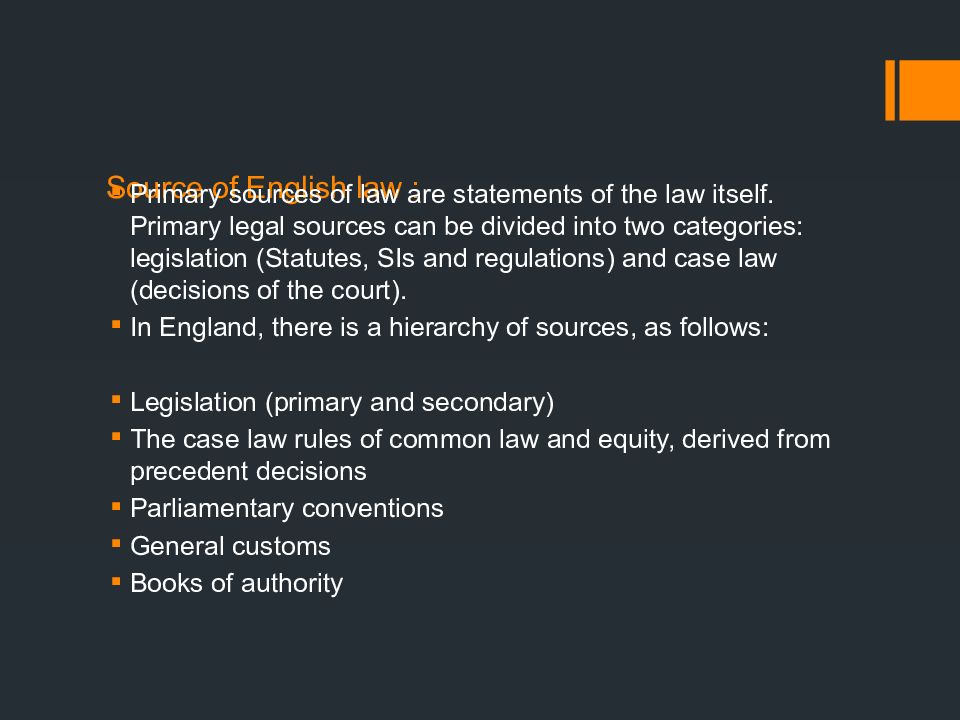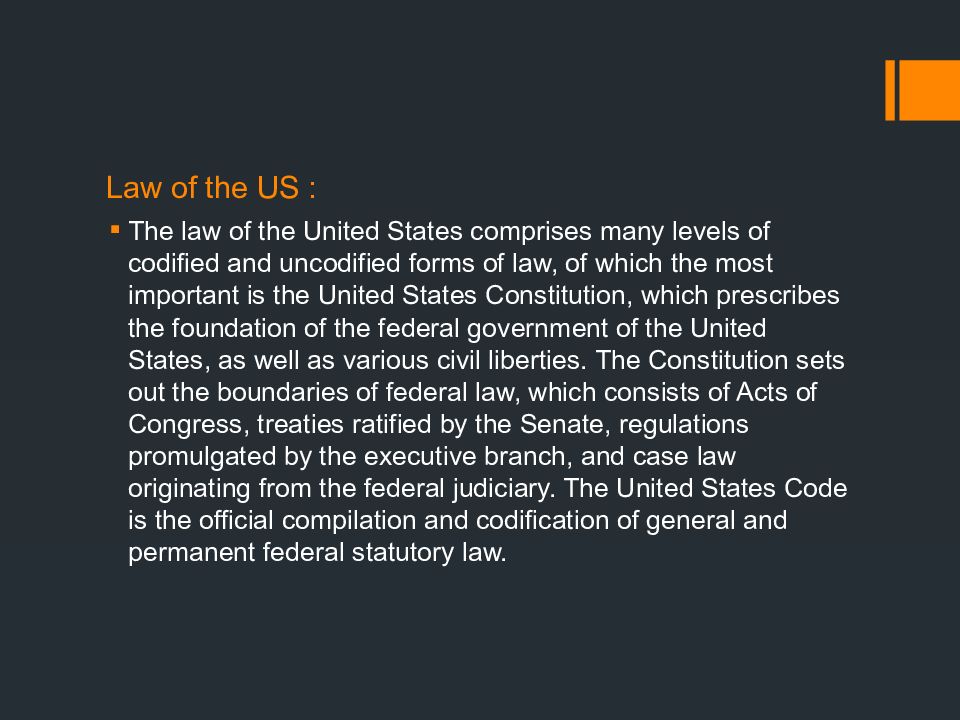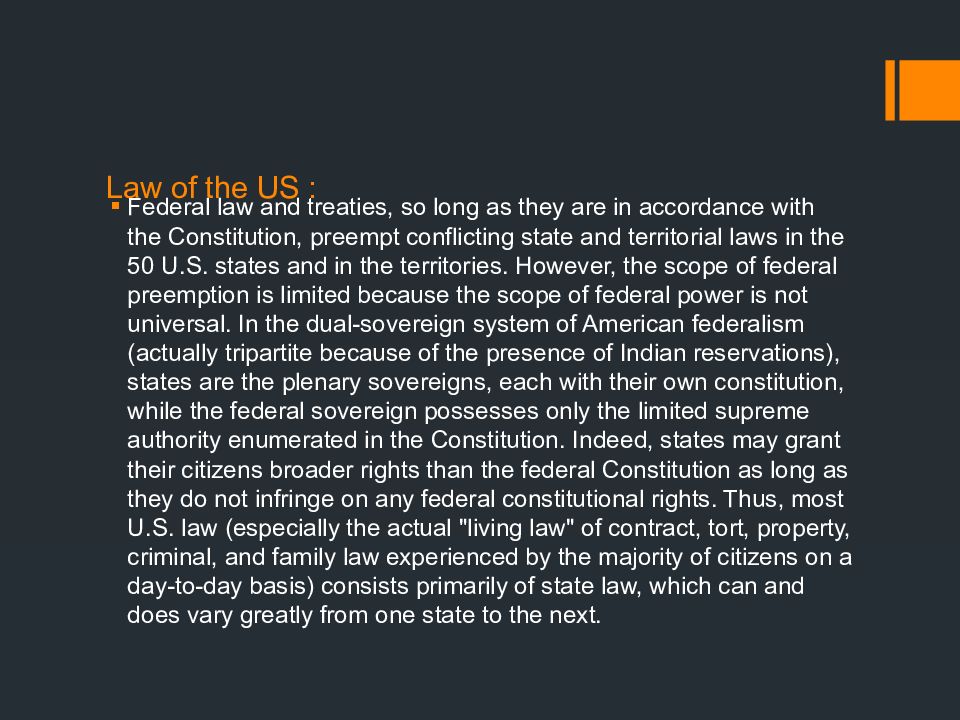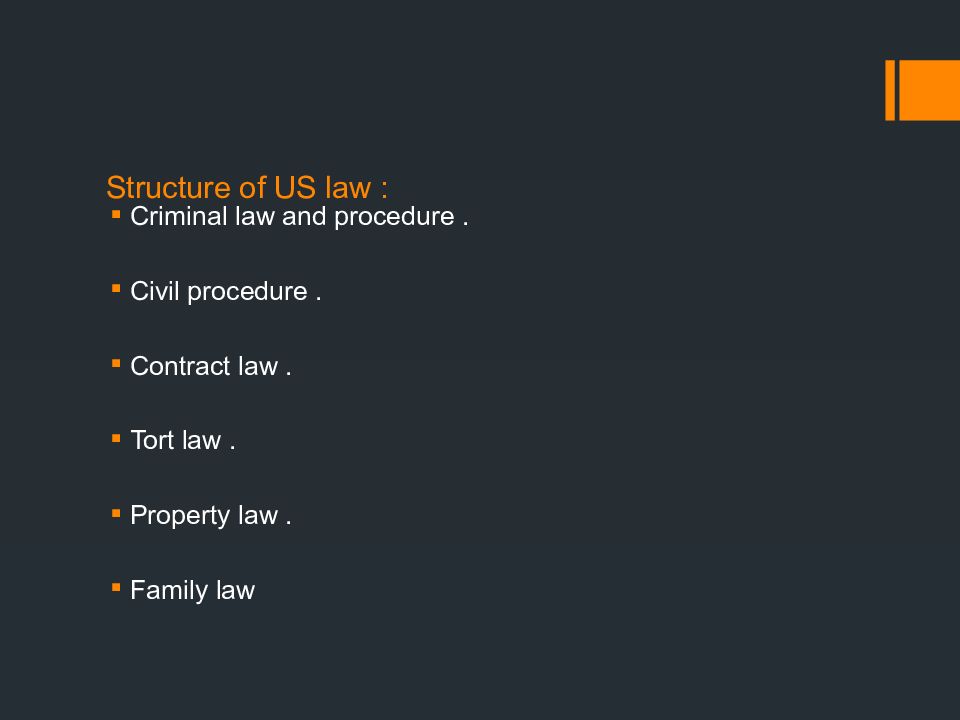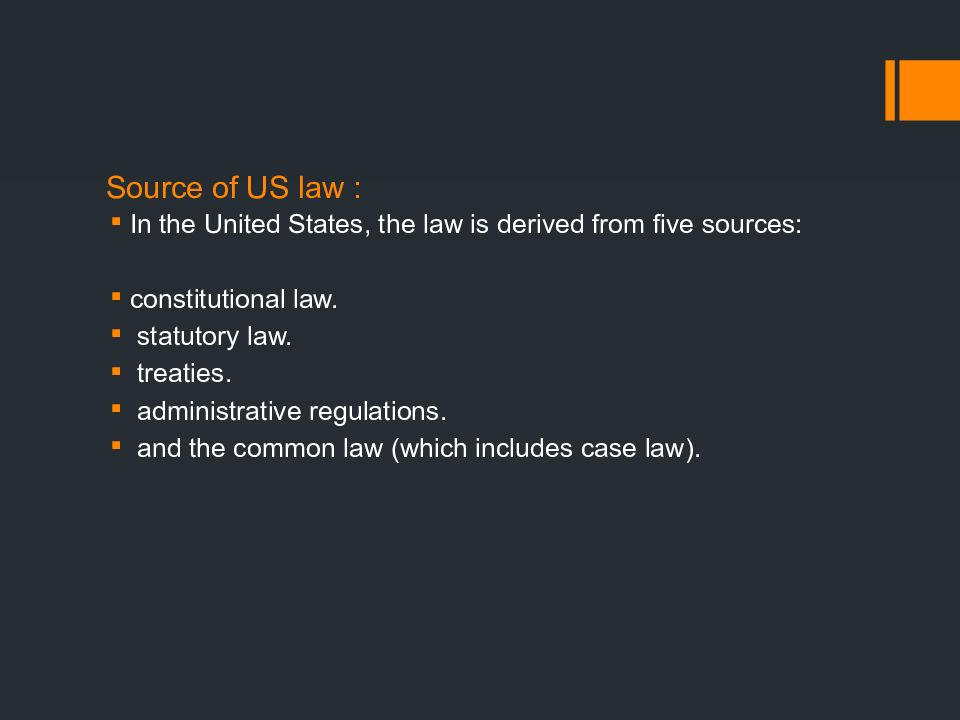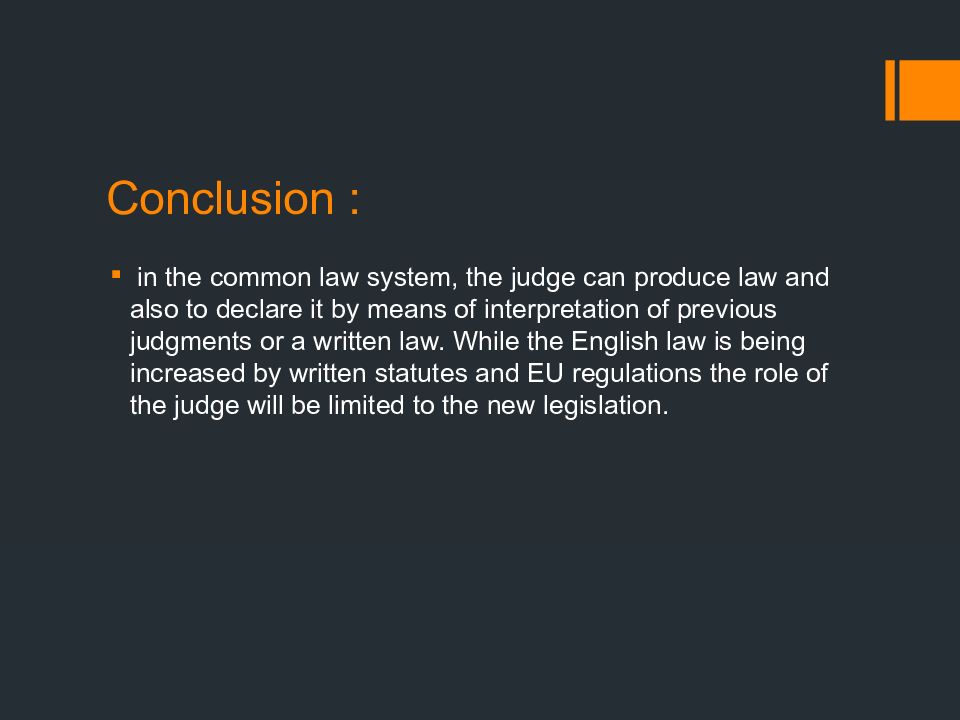Первый слайд презентации: Name: Farid Joseph Group: 19LS3a
Topic-3 : Legal system of the world 1) Common Law
Слайд 2: Contents :
1. Introduction of Common Law ……………….…. 3 2. Law in England ……………………………….…. 4 3. History of English law …………………………... 6 4. Structure of English law ………………………....7 5. Source of English law …………………………...8 6. Law of the US ………………………………….…9 7. History of US law ………………………………..11 8. Structure of US law ……………………………..12 9. Source of US law ………………………………..13 10. Conclusion ………………………………………14
Слайд 3: Introduction of Common Law :
In law, common law (also known as judicial precedent or judge-made law, or case law) is the body of law created by judges and similar quasi-judicial tribunals by virtue of being stated in written opinions. The defining characteristic of “common law” is that it arises as precedent. In cases where the parties disagree on what the law is, a common law court looks to past precedential decisions of relevant courts, and synthesizes the principles of those past cases as applicable to the current facts. If a similar dispute has been resolved in the past, the court is usually bound to follow the reasoning used in the prior decision (a principle known as stare decises ). If, however, the court finds that the current dispute is fundamentally distinct from all previous cases (called a "matter of first impression"), and legislative statutes are either silent or ambiguous on the question, judges have the authority and duty to resolve the issue (one party or the other has to win, and on disagreements of law, judges make that decision ). The court states an opinion that gives reasons for the decision, and those reasons agglomerate with past decisions as precedent to bind future judges and litigants. Common law, as the body of law made by judges, stands in contrast to and on equal footing with statutes which are adopted through the legislative process, and regulations which are promulgated by the executive branch (the interactions among these different sources of law are explained later in this article). Stare decises, the principle that cases should be decided according to consistent principled rules so that similar facts will yield similar results, lies at the heart of all common law systems.
Слайд 4: Law in England :
The United Kingdom has four legal systems, each of which derives from a particular geographical area for a variety of historical reasons: English law, Scots law, Northern Ireland law, and, since 2007, purely Welsh law (as a result of the passage of the Government of Wales Act 2006 by Parliament). However, unlike the other three, Welsh law is not a separate legal system per se, merely the primary and secondary legislation generated by the Send, interpreted in accordance with the doctrines of English law and not impacting upon English common law (except where such Welsh legislation ousts a common law rule by virtue of being a superior form of law). There is a substantial overlap between these three legal systems and the three legal jurisdictions of the United Kingdom: England and Wales, Scotland, and Northern Ireland. Each legal system defaults to its jurisdiction, each of whose courts further that law through jurisprudence. Choice of which jurisdiction's law to use is possible in private law: for example a company in Edinburgh, Scotland and a company in Belfast, Northern Ireland are free to contract in English law. This is not so in public law (for example, criminal law), where there are set rules of procedure in each jurisdiction. Overarching these systems is the law of the United Kingdom, also known as United Kingdom law (often abbreviated UK law). UK law arises from laws applying to the United Kingdom and/or its citizens as a whole, most obviously constitutional law, but also other areas, for instance tax law.
Слайд 5: Law in England :
The United Kingdom does not have a single legal system because it was created by the political union of previously independent countries. Article 19 of the Treaty of Union, put into effect by the Acts of Union in 1707, created the Kingdom of Great Britain but guaranteed the continued existence of Scotland's and England's separate legal systems. The Acts of Union of 1800, which joined Great Britain and Ireland into the United Kingdom of Great Britain and Ireland, contained no equivalent provisions but preserved the principle of different courts to be held in Ireland, of which the part called Northern Ireland continues to follow as part of the United Kingdom. The Supreme Court of the United Kingdom is the highest court in the land for all criminal and civil cases in England and Wales and Northern Ireland, and for all civil cases in Scots law. The Supreme Court is also the final court (in the normal sense of the term) for interpreting United Kingdom law. Note, however, that, unlike in some other systems (for example, the United States), the Supreme Court cannot strike down statutes and its precedents can be expressly overridden by Parliament, by virtue of the doctrine of Parliamentary sovereignty. The Supreme Court came into being in October 2009, replacing the Appellate Committee of the House of Lords. In England and Wales, the court system is headed by the Senior Courts of England and Wales, consisting of the Court of Appeal, the High Court of Justice (for civil cases) and the Crown Court (for criminal cases). The Courts of Northern Ireland follow the same pattern. In Scotland the chief courts are the Court of Session, for civil cases, and the High Court of Justiciary, for criminal cases. Sheriff courts, as they deal with both criminal and civil caseloads, have no equivalent outside Scotland.
Слайд 6: History of English Law :
The English common law originated in the early Middle Ages in the King's Court (Curia Regis), a single royal court set up for most of the country at Westminster, near London.... The common law of England was largely created in the period after the Norman Conquest of 1066.
Слайд 7: Structure of English law :
Criminal law and civil law. Common law and civil law. Common law and equity. Public law and private law. Legal remedies.
Слайд 8: Source of English law :
Primary sources of law are statements of the law itself. Primary legal sources can be divided into two categories: legislation (Statutes, SIs and regulations) and case law (decisions of the court ). In England, there is a hierarchy of sources, as follows : Legislation (primary and secondary) The case law rules of common law and equity, derived from precedent decisions Parliamentary conventions General customs Books of authority
Слайд 9: Law of the US :
The law of the United States comprises many levels of codified and uncodified forms of law, of which the most important is the United States Constitution, which prescribes the foundation of the federal government of the United States, as well as various civil liberties. The Constitution sets out the boundaries of federal law, which consists of Acts of Congress, treaties ratified by the Senate, regulations promulgated by the executive branch, and case law originating from the federal judiciary. The United States Code is the official compilation and codification of general and permanent federal statutory law.
Слайд 10: Law of the US :
Federal law and treaties, so long as they are in accordance with the Constitution, preempt conflicting state and territorial laws in the 50 U.S. states and in the territories. However, the scope of federal preemption is limited because the scope of federal power is not universal. In the dual-sovereign system of American federalism (actually tripartite because of the presence of Indian reservations), states are the plenary sovereigns, each with their own constitution, while the federal sovereign possesses only the limited supreme authority enumerated in the Constitution. Indeed, states may grant their citizens broader rights than the federal Constitution as long as they do not infringe on any federal constitutional rights. Thus, most U.S. law (especially the actual "living law" of contract, tort, property, criminal, and family law experienced by the majority of citizens on a day-to-day basis) consists primarily of state law, which can and does vary greatly from one state to the next.
Слайд 11: History of US law :
Background. At both the federal and state levels, the law of the United States was mainly derived from the common law system of English law, which was in force at the time of the Revolutionary War. However, U.S. law has diverged greatly from its English ancestor both in terms of substance and procedure.
Слайд 12: Structure of US law :
Criminal law and procedure. Civil procedure. Contract law. Tort law. Property law. Family law
Слайд 13: Source of US law :
In the United States, the law is derived from five sources: constitutional law. statutory law. treaties. administrative regulations. and the common law (which includes case law).
Последний слайд презентации: Name: Farid Joseph Group: 19LS3a: Conclusion :
in the common law system, the judge can produce law and also to declare it by means of interpretation of previous judgments or a written law. While the English law is being increased by written statutes and EU regulations the role of the judge will be limited to the new legislation.
